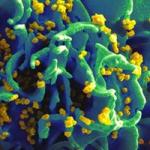
Daniel Howard Appella, Ph.D.
Senior Investigator
Synthetic Bioactive Molecules Section, Laboratory of Bioorganic Chemistry
NIDDK
Research Topics
Through our research, we hope to develop the next generation of diagnostics and therapeutics to detect and treat human diseases.
Current Research
Our research uses synthetic organic chemistry to create new molecules with unique biological activity. Each project has the potential to evolve into a new strategy for diagnosing or treating a disease. We spend most of our time synthesizing molecules, but we also use molecular modeling to design our molecules and employ biophysical techniques to study the molecules we make. We collaborate with other NIH scientists as well as outside research organizations to study the biological effects of our molecules in vivo. Specific projects of our group are summarized below.
We are developing new types of peptide nucleic acids (PNAs) for use in detection of nucleic acids as well as for multivalent display at the nanometer scale. The traditional form of PNA consists of an aminoethylglycine backbone to which nucleobases are attached. These molecules bind to complementary DNA (deoxyribonucleic acid) and RNA (ribonucleic acid) with high affinity and sequence specificity. We have developed chemical strategies that can be used to functionalize and/or pre-organize this class of molecules while preserving the binding properties to complementary nucleic acids. Specifically, we have incorporated a cyclopentane ring into the PNA backbone to enhance the nucleic acid binding properties of PNA. Using this modification, we have shown that detection of nucleic acids derived from pathogens is greatly improved. We are engaged in developing new diagnostic techniques based on this chemically-modified version of PNA. In addition to cyclopentane modifications, we have introduced γ-lysine-modified PNA and developed a method to use this PNA in a novel approach to examine multivalent binding. Multivalent effects dictate the binding affinity of multiple ligands on one molecular entity to receptors. By attaching ligands to the γ-lysine sidechains of the modified PNA, we can assemble libraries of multivalent assemblies and probe for biological activity. Using ligands specific for an integrin receptor, we have shown that the optimized γ-Lys-PNA multivalent scaffold improves biological activity of the ligand by two orders of magnitude in both cell-based and in vivo models of cancer metastasis. Our method should be generally applicable to study any multivalent binding event in biology.
We are also developing new types of small molecules that interact with biological targets considered to be challenging for drug development. The goal is to develop new types of therapeutic compounds that take advantage of unique mechanisms of action. In this area, we are examining small molecules that inactivate the nucleocapsid protein (NC) of HIV. We have found that 2-mercaptobenzamides with simple alanine sidechains inactivate NC of HIV via an acyl transfer mechanism that is catalytic within the intracellular environment. The molecules we have developed have good antiviral activity and we are currently examining whether these molecules can be further developed into new drugs to combat HIV infection.
Applying our Research
We hope to provide more reliable methods to detect human disease and also provide therapeutic strategies for treatment.
Need for Further Study
Our research can develop diagnostics based on genetic signatures of diseases, so new nucleic acid sequences that are markers of disease would help move our diagnostic area forward. Developing new therapies requires large investments in organic chemists making new molecules and the associated infrastructure to test the molecules for biological activity and toxicity. Additional funds to support such efforts are certainly needed.
Biography
- Assistant Professor, Northwestern University, 2001-2004
- Postdoctoral Fellow, Massachusetts Institutes of Technology, 1998-2001
- Ph.D., University of Wisconsin-Madison, 1998
Selected Publications
- Clausse V, Zheng H, Amarasekara H, Kruhlak M, Appella DH. Thyclotides, tetrahydrofuran-modified peptide nucleic acids that efficiently penetrate cells and inhibit microRNA-21. Nucleic Acids Res. 2022;50(19):10839-10856.
- Robello M, Zheng H, Saha M, George Rosenker KM, Debnath S, Kumar JP, Tagad HD, Mazur SJ, Appella E, Appella DH. Alkyl-substituted N-methylaryl-N'-aryl-4-aminobenzamides: A new series of small molecule inhibitors for Wip1 phosphatase. Eur J Med Chem. 2022;243:114763.
- Clausse V, Fang Y, Tao D, Tagad HD, Sun H, Wang Y, Karavadhi S, Lane K, Shi ZD, Vasalatiy O, LeClair CA, Eells R, Shen M, Patnaik S, Appella E, Coussens NP, Hall MD, Appella DH. Discovery of Novel Small-Molecule Scaffolds for the Inhibition and Activation of WIP1 Phosphatase from a RapidFire Mass Spectrometry High-Throughput Screen. ACS Pharmacol Transl Sci. 2022;5(10):993-1006.
- Amarasekara H, Oshaben KM, Jeans KB, Rezvan Sangsari P, Morgan NY, O'Farrell B, Appella DH. Cyclopentane peptide nucleic acid: Gold nanoparticle conjugates for the detection of nucleic acids in a microfluidic format. Biopolymers. 2022;113(3):e23481.
- Zheng H, Botos I, Clausse V, Nikolayevskiy H, Rastede EE, Fouz MF, Mazur SJ, Appella DH. Conformational constraints of cyclopentane peptide nucleic acids facilitate tunable binding to DNA. Nucleic Acids Res. 2021;49(2):713-725.
Related Scientific Focus Areas


Microbiology and Infectious Diseases
View additional Principal Investigators in Microbiology and Infectious Diseases



This page was last updated on Wednesday, January 10, 2024